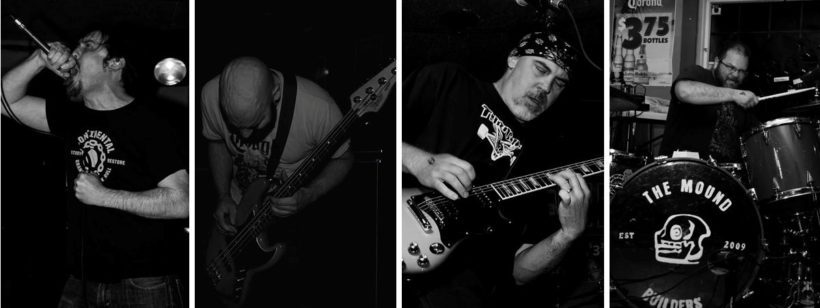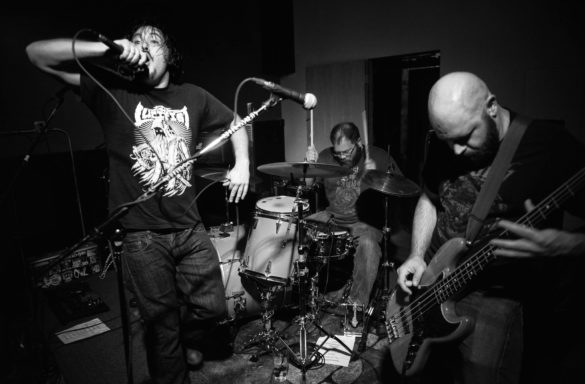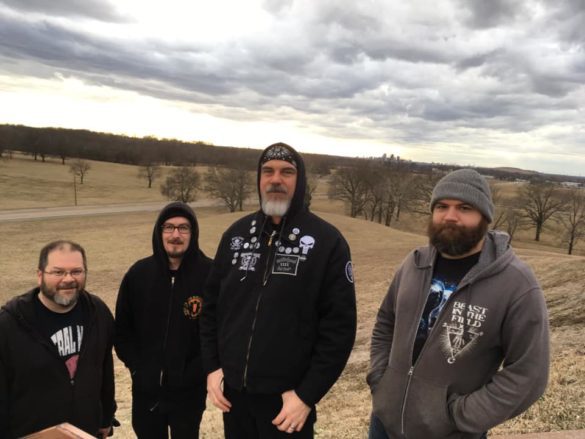
Formed about an hour northwest of the Indianapolis speedways in Lafayette, the foundation of sludge rockers The Mound Builders was constructed through a local ad. Seeking musicians who dig bands as diverse as Down, Helmet, and Sepultura, the ad was a fishing lure that united future collaborators Brian Boszor (guitars) and Jason “Dinger” Brookhart (drums). After recruiting the rest of the band and auditioning vocalist Jim Voelz, The Mound Builders started shaping the band’s identity from their collective influences and creative instincts. Like Corrosion of Conformity bridged everything from crust and sludge to thrash and hard rock, The Mound Builders are at home playing with Crowbar or headlining Punk Rock Night at Indianapolis staple The Melody Inn.
That’s where I first saw The Mound Builders, playing a tight but spirited set to the faithful fanatics who help keep Indiana’s loud ‘n’ heavy scene healthy. When I witnessed their set I didn’t know The Mound Builders had nearly had a decade of experience playing together, but it sure as hell sounded like it. Over time they’ve stretched their subgenre limbs and found their preferred balance of brawn and groove, propelled by punk adrenaline and Sabbathian stoner flourishes. In a live setting, The Mound Builders are party sludge with a brain. Several members are history buffs; they can pound a sixer of local craft brews while researching regional legends. Along with their album Wabash War Machine, their band name itself is a reference to the civilizations before American industrialization of the Midwest. If you travel through the Midwest, you’ll find mounds of all sizes that are remnants of societies historians still struggle to accurately identify. Some mounds were constructed for communal habitation and worship; others a place for burial where bones and arrowheads have been excavated.
After founding bassist “Ninja” Nate Malher passed away in 2015 following a battle with leukemia, The Mound Builders were crushed. Asked about the history of his basement doubling as the band’s rehearsal space, Boszor still feels compelled to share the painful memory of removing Malher’s gear from the space. But The Mound Builders soldiered on. The band now organizes an annual benefit show in Malher’s honor called N8FEST and donates its proceeds to the Purdue Center for Cancer Research and Dolly Parton’s Imagination Library. While the band has had to modify songs composed for a five-piece group, they’ve never erased their fallen comrade’s history.
Last December, The Mound Builders gave riff-hounds a Christmas gift by releasing a new eponymous LP. A decade into their history, the album is both a composite of the road leading to this very point and a fresh take on the many facets of their sound: a high-energy blend of beard metal, end-times doom, party sludge, and rust belt hardcore. While they’ve experienced thrilling highs and heart-wrenching lows, The Mound Builders add to their rich history one sweaty show at a time. I’m not gonna lie—when I first moved to Indianapolis from Philadelphia I was concerned about leaving a helluva scene behind. But seeing The Mound Builders bash out “Hair of the Dogma” helped bury and dismiss that anxiety.
Stream The Mound Builders below. Also check out an interview with the band as they reflect upon ten years of rattling Indiana and the other states lucky to be within earshot.
After meeting from the wanted ad, how did you know you connected with the right collaborator?
Jason “Dinger” Brookhart, drums: “Brian and I got along right away. We had similar interests like Star Wars and other sci-fi movies and TV shows like Lost. He had access to a space for practicing and was somewhat established in the local music community. I was relatively new to town and didn’t really know that many people who played heavy music.”
Brian Boszor, guitars: “I would say Dinger’s playing style. I could tell right away he put a lot of emphasis on the down beat and establishing a groove.”
I know the band started through a replied ad, but how did you enter the fold? Who did you know in the band?
Jim Voelz, vocals: “I actually didn’t know any of ‘em. I had only met the bass player Ryan [Strawsma] once at another show. But I hadn’t really known any of the guys. I was playing in another band and a mutual friend said they were looking for a vocalist, and thought I’d be a good match for them. I knew who they were and was aware of the band. I had seen them play before, and it was basically the only metal band around at the time that gelled with my taste. I auditioned, and apparently was the only one who rehearsed any of the songs. So they went with me and I guess the rest is history.”
How did you know Voelz was the right voice for The Mound Builders?
Ryan Strawsma, bass: “Preparation and work ethic, mainly. We had a few people interested in the role of vocalist, but Jim was the first guy to walk into his audition with the songs rehearsed and fresh in his head. We noticed he how he put in the extra effort, and that was how we ultimately knew he was the right guy for this band.”
Where have you rehearsed through the years?
Voelz: “That’s in Brian’s basement, and we’re still there. When this all started forming we were all younger, Brian wasn’t married yet, nobody had kids. So as time moved on and we started settling down, we figured we can’t go to Brian’s house after he had a kid because we’re a bunch of crusty dudes drinking beer in the basement and playing really loud music. So we tried finding a rehearsal space but it’s really expensive; it’s hard to find a place to rehearse around here that won’t cost you an arm and a leg. So we moved into this other space in this industrial area on the south end of town. We fixed it up, it was a real piece of work and it was really gross. We practiced there for a few months and got broken into, a bunch of stuff got stolen. So we decided for now we’ll go back to Brian’s place; at least we won’t get robbed.”
How has that space changed over the years?
Voelz: “It’s got more posters hanging on the wall. We hang up flyers for all the shows we’ve played, and we’ve filled the walls, there’s no more room. So now we have an art portfolio book we put them in.”

How was your 10th anniversary show [February 23rd at North End Pub in Lafayette]?
Voelz: “It couldn’t have gone better. We had a great turn-out,. All our friends came out. A good chunk of people from Indianapolis came out. We played North End Pub which used to be called Jerilee’s for our 10 year anniversary, because that’s basically where the band started.”
Did you celebrate in any special way for the show?
Voelz: “I was digging through some of the older merch boxes and found a copy of one of the comic books we put out with the first 100 CDs of Wabash War Machine. We had Adam Black and 4 or 5 artists involved with it. This comic book pulled all the songs together and made a story out of them. I also found old posters and shirts for the merch table as well. We also did a medley that was almost the whole Strangers in a Strange Land album and ran them together. We pulled stuff apart and played the intro, went into “Sun God” and “Ironhide” and “White Horse”. It was a 7 or 8 minute medley. We also played “Narcomancer” and “Wake of the Red Witch,” which we haven’t played in a bunch of years. After a while we get bored of playing the same stuff, so we rewrite stuff and reconstruct songs now that we’re a four-piece, since those older albums had dueling guitars. We’ve taken old songs that have been neglected and revamped them into something new and different. Sometimes we’ll write a song and put it in the set list and then realize we’ve been playing a song for two years before it’s even recorded.”
What do they think of your first recordings now that you’ve been creating music for a decade?
Voelz: “It’s interesting you ask that. [2011’s] Strangers in a Strange Land was a big stepping stone for everybody. Nobody has really put that much effort into a recording before. We’ve been in a bunch of bands separately, but this was a big deal for all of us. We spent a lot of time and a lot of money in the studio recording that. We were so excited about and ready to record the next batch of songs. But you go back and listen and there’s things we were disappointed in production and performance wise. But we revisit that album to see if we’ve evolved. Without that album we’d have no foundation to gauge where we’re at. Are we continuing to move forward? Are we better at writing and performing songs? I don’t want to come out and say it sucks, a lot of bands do that and I understand, because you are constantly trying to improve. You’d have to be an asshole to look at your old albums and say they’re perfect. Without that older stuff we couldn’t have the new stuff. It’s all just part of the story, you know?”
What were your goals when writing the new album?
Boszor: “We definitely wanted to write an album with a flow to it rather than just a collection of songs. We wanted to stretch out on a couple of longer songs while trying to keep them interesting.”
Strawsma: “We were really trying to separate ourselves more from that early material, because lot of those songs were just throwing our influences at the wall and seeing what stuck. But our music has evolved so much over the years, and we didn’t feel we had anything on hand that characterized our present day sound. So the angle we were going for with this self-titled record was trying to reestablish and reinvent ourselves in a way.”

When you selected the name The Mound Builders, it seemed like an homage to local Wabash history. But what symbolism of the mounds have you found most fascinating?
Voelz: “Early on we had quite a lot of stuff based on that imagery. [Boszor] and I are history buffs, so we immediately connected and bonded over that. Talking to him, he’d send me links and magazine articles to ancient civilization discoveries. But there’s a sense of mystery; nobody knows exactly what happened to these civilizations or the exact purposes of the mounds. We were out in St. Louis playing a show in March driving on the interstate. We passed one of largest known mounds in North America. I saw it and said, “Hey isn’t that a mound?” Brian said it’s the Cahokia Mounds. So I said, “Uh, shouldn’t we go there?” So we went there, took some pictures, climbed up it, and it’s huge. We got to the top and saw across the valley, you could see the [St. Louis] arches on the horizon. It was really inspiring for me since I had never been there before. It sort of resparked my interest in studying civilizations. They’ve studied these sites for years and have a general story, but you could study forever and not get the full story.”
Boszor: “Monks Mound at Cahokia Mounds State Historic Site near St. Louis has a bigger footprint than the Great Pyramid Of Giza. That sounded like an interesting history to learn more about.”
Brookhart: “I liked the idea that it was a relatively unexplored topic and it left a lot to interpretation and imagination. Some stories say they were giants or aliens or whatever else, it seemed like a subject you could have fun with.”
What were some of your favorite experiences and achievements over the past decade?
Brookhart: “Being able to play music with the same people for over 10 years is a personal achievement for me. I think that you are able to develop as musicians over time and like a wine that gets better with age so do bands that stick together. One of the best experiences for me was having Matt Swisher of Failure Records & Tapes take his own money and trust complete strangers by investing in their music. Having someone outside of the band invest in the band financially is a pretty awesome feeling.”
Voelz: “Playing that great stage at Reggie’s in Chicago with The Skull. For years we were kicking around Lafayette, sometimes Indy and Frankfurt and Terra Haute and places we knew people. Playing in bars with pieced-together PAs, or basement and house shows. So that felt amazing.”
Strawsma: “It was cool to share the stage with some of the bands that have been big influences to us like Crowbar and Black Tusk. It’s hard to really measure our achievements though, cause it feels like we keep outdoing ourselves every subsequent year.”
What do you see in the future of The Mound Builders?
Voelz: “Doing what we do. We love to play shows and meet new people and bands, see old friends. We have pockets of friends all around the Midwest and try to see them at least once a year. Yesterday the guys were in a makeshift studio tracking demos. Not sure what we’ll do with them yet; the idea of putting out another album right now is crushing and stressful to think about. In 2018 we released a 7” and re-released Wabash War Machine the way it was supposed to be before we ran out of time and money. So I sort of want to take a breath. But we’ve been working on new material, and we’ll keep writing. I’m sure a lot of bands can relate to that. When you’re rehearsing for shows and playing live, it’s hard to write while you’re staying tight. So the next half of the year will be trying to get our record out there, and hopefully have new material in some form for next year.”
Brookhart: “We seem to be writing new music right now. We’ve got a couple things demoed out and “in the process” so to speak. So I think that we will continue writing in some capacity. We’re booked through July and booking fall/winter and beyond now. So, we will continue to play as much as we can and get this new record to as many new ears as we can.”
Strawsma: “Play shows, push this record, rinse and repeat.”
Order this bruising new album from The Mound Builders HERE
Don’t forget to follow them on Facebook for tour dates and their next mound visitations HERE






